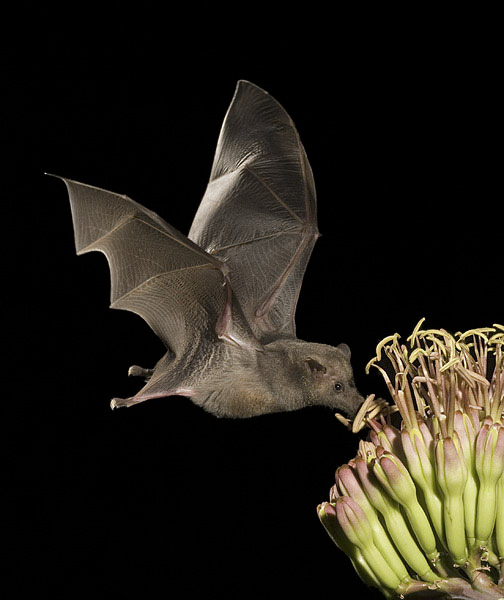We have seen that many nectarivorous bats have evolved highly specialized morphological and behavioral adaptations to maximize their feeding efficiency. However, there are cases of facultative nectarivory and frugivory in some bat species that could be demonstrating a gradual evolution towards more obligate feeding patterns. Such is the case of the pallid bat (Antrozous pallidus), a primarily insectivorous microbat from Central and southern North America (Figure 1). A. pallidus has been observed visiting flowers and drinking the nectar of the cardon columnar cactus (Pachycereus pringlei) in northwestern Mexico, and represents the first case of facultative nectarivory in a bat outside of the New World microbat family Phyllostomidae (A. pallidus is in family Vespertilionidae) (Frick et al. 2012). Such behavior from an insectivorous bat may represent the evolutionary processes that took place nearly 40 million years ago, when obligate nectarivory first emerged in bat lineages (Kunz and Fenton 2003).

Figure 1. Tuttle, M. 2014. Pallid bat (Antrozous pallidus) sipping nectar from a flower of a columnar cactus. A. pallidus is most typically a gleaning insectivore, snatching arthropods and insects off the ground. https://www.thedodo.com/the-work-of-a-real-batman-843781039.html; retrieved 19/4/2015.
In a recent study in northwestern Mexico, experimental results show that A. pallidus actually deposits more pollen at cactus flowers per visit than the obligate nectarivore the lesser long-nosed bat (Leptonycteris yerbabuenae), suggesting the pallid bat may in fact be a more effective pollinator than a highly specialized nectarivore (Frick et al. 2012; Figure 2). This is mainly due to the feeding mechanisms of the pallid bat; since it is not specialized to hover and quickly extract nectar like the lesser long-nosed bat is, the pallid bat lands on the flowers and plunges its face and tongue into the flower to extract nectar. This increases physical contact between the bat and the flower, increasing the chance of pollen transfer at each flower visit (Frick et al. 2012).
Fig 2. Frick et al. 2012. Average pollen loads on cactus flower stigmas per visit by A. pallidus and L. yerbabuenae. A. pallidus, the facultative nectarivore, deposited significantly more pollen at cactus flowers per visit than did L. yerbabuenae. Reprinted from Frick et al. (2012); retrieved 19/4/2015.
This behavior of facultative nectarivory by a primarily insectivorous bat could exemplify the evolutionary processes that take place to develop obligate nectarivory. Whereas the highly specialized lesser long-nosed bat has adaptations to increase feeding efficiency and reduce metabolic costs, the pallid bat still expends a significant amount of energy while feeding on nectar due to a lack of traits specialized for nectarivory (Frick et al. 2014). It is possible that the pallid bat could eventually develop more adaptations specific to nectarivory given the proper selective pressures and mutations.

